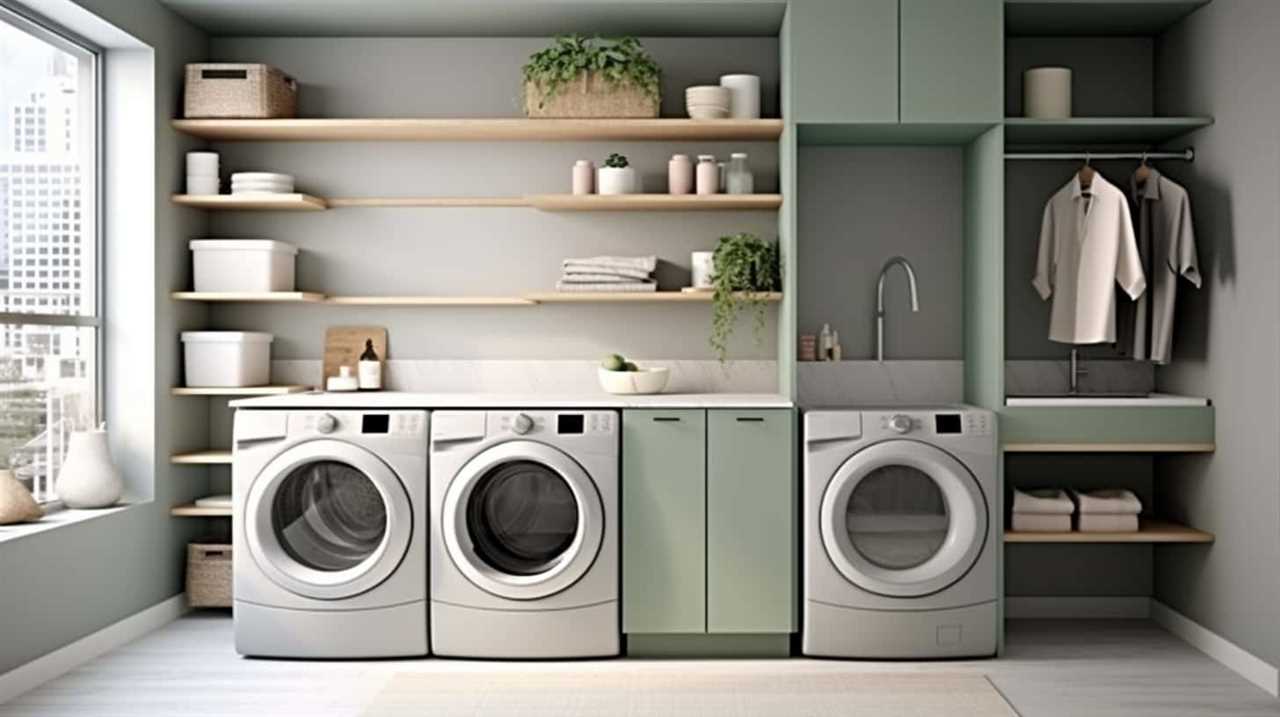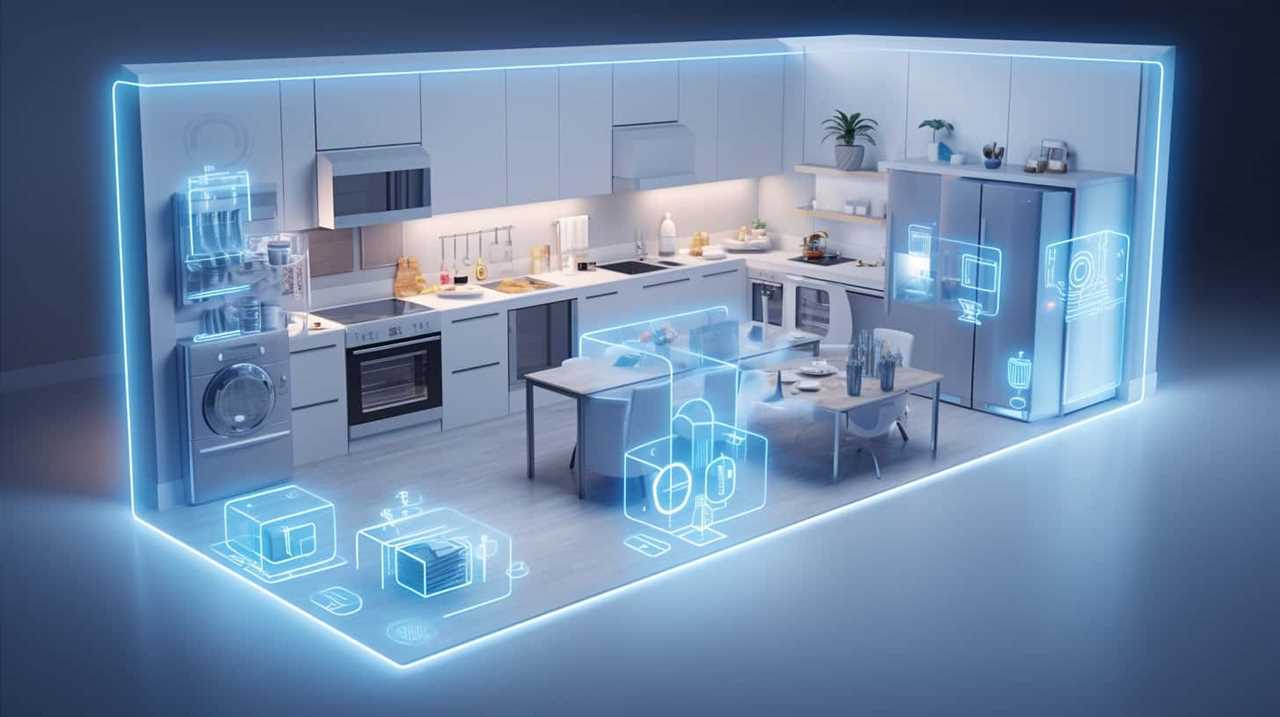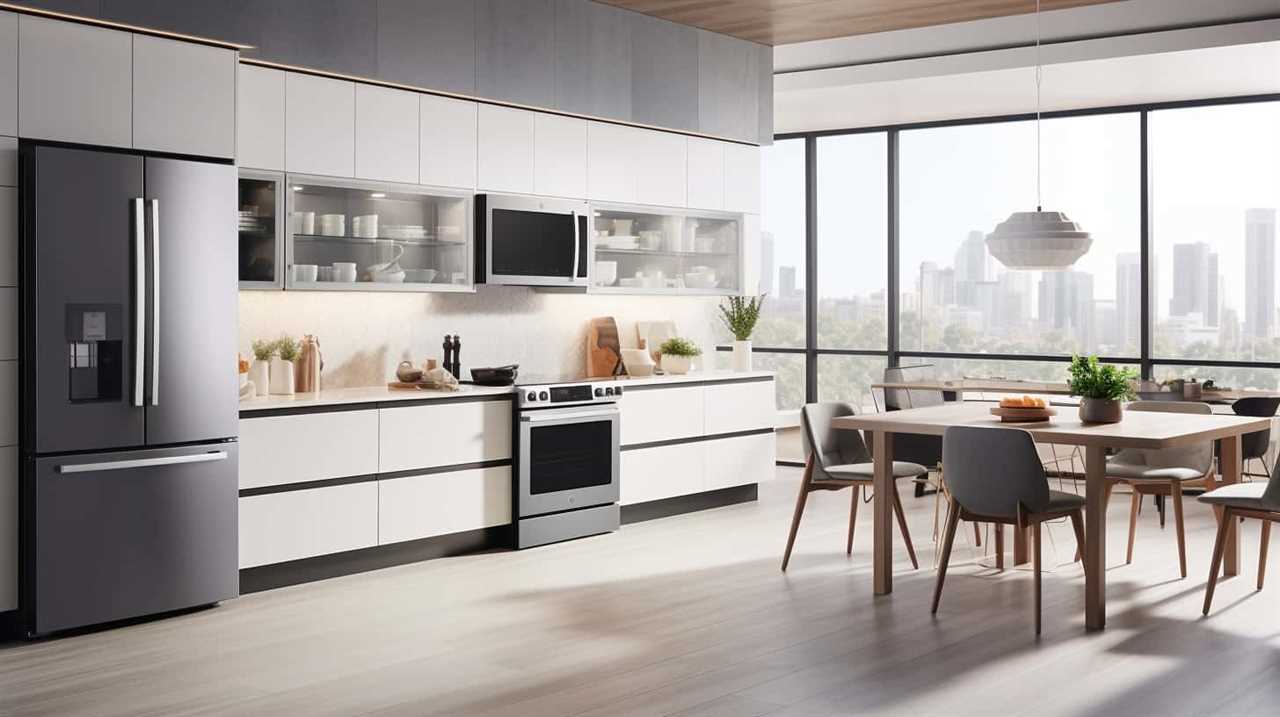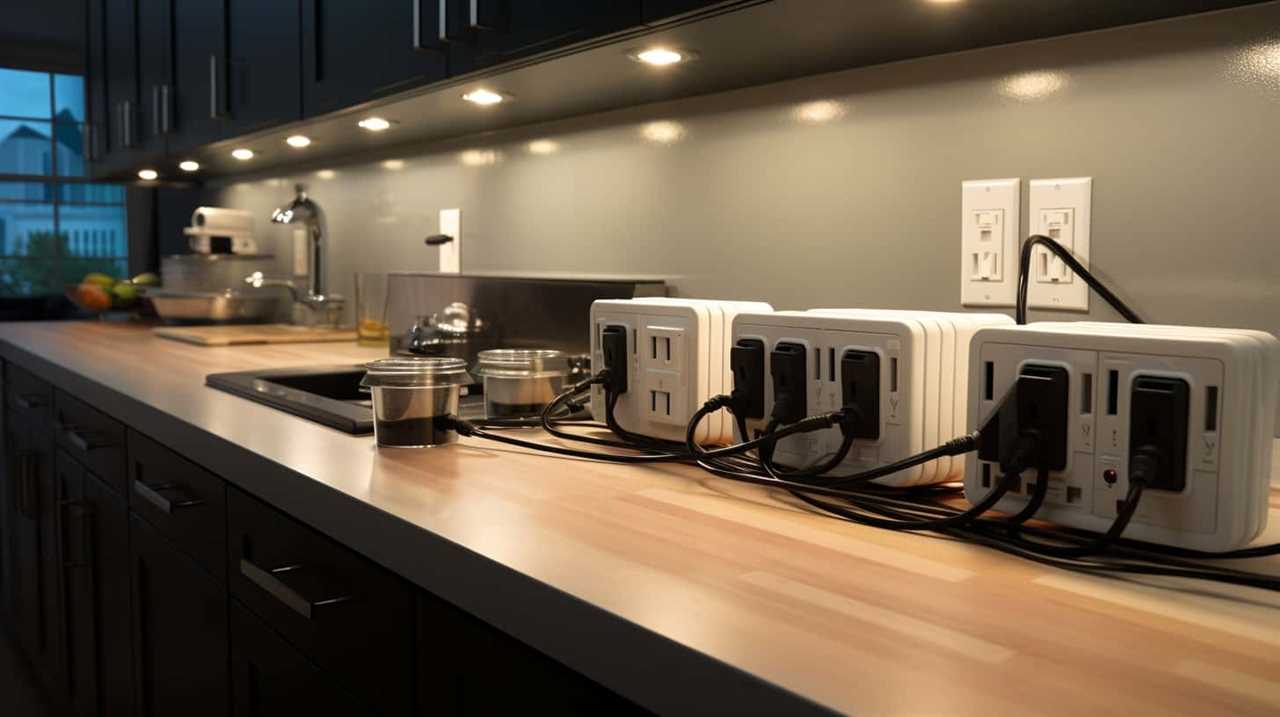As consumers, we are always surrounded by a variety of devices that help simplify our lives. Have you ever stopped to consider whether these devices should be classified as appliances or electronics?
In this article, we will explore the distinction between the two and shed light on the key differences. By understanding this distinction, we can make more informed decisions when it comes to purchasing and using these devices.
So, let’s dive in and unravel the world of appliances and electronics together.
Key Takeaways
- Appliances are designed for specific tasks, while electronics serve a wider range of functions.
- Appliances rely on electricity or gas as power sources, while electronics often require batteries or a direct power source.
- Appliances are built to withstand heavy use and have a longer lifespan, while electronics may become obsolete more quickly.
- Appliances generally have higher power consumption compared to electronics.
Definition of Appliances Vs Electronics
As we delve into the topic of ‘Definition of Appliances vs Electronics’, let’s begin by clarifying the distinction between these two categories.

Appliances and electronics are often used interchangeably, but they’ve distinct characteristics that set them apart. Appliances are devices designed to perform specific tasks or functions, such as cooking, cleaning, or refrigeration. They’re typically larger in size and have a more utilitarian design, focusing on functionality rather than aesthetics.
On the other hand, electronics refer to devices that involve the use of electrical circuits for communication, computation, and entertainment purposes. They’re often smaller and more portable, with a greater emphasis on design and aesthetics.
Understanding the difference between appliances and electronics is crucial in order to make informed decisions when purchasing and using these devices.
Now, let’s explore the common characteristics of appliances.

Common Characteristics of Appliances
When examining the common characteristics of appliances, there are several key points to consider.
First, functionality and purpose play a crucial role in distinguishing appliances from other electronic devices. Appliances are designed to perform specific tasks, such as cooking or cleaning, while electronics have a broader range of functions.
Additionally, the design and aesthetics of appliances often prioritize practicality and integration into the home environment, while electronics may focus more on sleekness and technological features.
Lastly, energy efficiency ratings are an important characteristic of appliances, as they impact both environmental sustainability and long-term cost savings.

Functionality and Purpose
We have observed that most appliances share common characteristics in terms of functionality and purpose. When it comes to functionality, appliances are designed to perform specific tasks efficiently and effectively. They’re created with a clear purpose in mind, whether it be cooking, cleaning, or providing comfort.
In terms of aesthetics, appliances are often designed to blend in with the overall decor of a space, but functionality takes precedence over appearance.
Here are three common characteristics of appliances:
- Energy efficiency: Appliances are designed to consume minimal energy while still delivering optimal performance. This not only helps to reduce electricity bills but also contributes to a more sustainable and environmentally friendly lifestyle.
- Power source requirements: Appliances have specific power source requirements, whether it be electricity, gas, or batteries. Understanding these requirements is crucial for proper usage and maintenance of the appliances.
- Safety features: Appliances are equipped with safety mechanisms to protect users from accidents or mishaps. These features may include automatic shut-off, child locks, or temperature control, ensuring that appliances can be used with peace of mind.
Understanding these common characteristics helps consumers make informed decisions when selecting and using appliances, leading to a more efficient and enjoyable household experience.

Design and Aesthetics
Design and aesthetics are crucial in the success of appliances, as they have a significant impact on consumer behavior. Consumers look for functionality, durability, and products that enhance the overall visual appeal of their homes. Appliances with sleek and modern designs, clean lines, and attractive finishes are more likely to attract consumers. Additionally, appliances that blend seamlessly with the existing decor and style of a home are highly sought after.
Design and aesthetics can also influence the perception of quality and reliability. Consumers are more likely to choose appliances that are visually pleasing and well-designed. In conclusion, the design and aesthetics of appliances are essential factors that contribute to their appeal and influence consumer buying decisions.
Energy Efficiency Rating
Appliances with a high energy efficiency rating are becoming increasingly important in today’s environmentally conscious world. When choosing appliances, it’s crucial to consider their energy efficiency rating as it directly impacts both the environment and your electricity bills.
Here are three key points to consider regarding energy efficiency ratings:

- Lower energy consumption: Appliances with higher energy efficiency ratings consume less power, which means they’re more efficient and cost-effective over time. By opting for energy-efficient appliances, you can reduce your carbon footprint and contribute to a greener future.
- Energy savings: Investing in appliances with high energy efficiency ratings can lead to significant energy savings. These appliances are designed to use less electricity, resulting in lower utility bills and long-term financial benefits.
- Power source requirements: Energy-efficient appliances often require less power to operate, making them ideal for areas with limited power availability or renewable energy sources. By choosing these appliances, you can maximize the use of alternative energy sources and reduce reliance on traditional fossil fuels.
Considering the energy efficiency rating and power source requirements of appliances is essential for both environmental sustainability and cost-effectiveness.
Common Characteristics of Electronics
When it comes to discussing the common characteristics of electronics, there are several key points to consider.
First, the functionality of electronic devices is a defining feature, as they’re designed to perform specific tasks or provide certain services.
Additionally, the impact of technology advancements is another important aspect, as electronics constantly evolve and improve over time.

Lastly, the integration of electronics with other systems, such as smart home automation or interconnected devices, further demonstrates their common characteristics.
Functionality of Electronic Devices
In our daily lives, we rely on electronic devices for various tasks and activities. The functionality and design of electronic devices play a crucial role in their usability and effectiveness. Here are three common characteristics of electronic devices that enhance their functionality:
- User-friendly interfaces: Electronic devices are designed with intuitive interfaces that make them easy to operate. Clear icons, touchscreens, and well-organized menus ensure a seamless user experience.
- Versatile features: Electronic devices offer a wide range of features that cater to different needs. From smartphones with advanced camera capabilities to smart home devices with voice control, these features provide convenience and enhance productivity.
- Connectivity options: Electronic devices are equipped with various connectivity options, such as Wi-Fi, Bluetooth, and NFC. This allows seamless integration with other devices and enables data sharing and syncing.
Impact of Technology Advancements
As we delve into the impact of technology advancements, it’s important to recognize the common characteristics of electronics that continue to shape our daily lives.
The rapid pace of technology advancements has brought about a myriad of changes that have had a profound impact on how we live, work, and interact with the world around us. From the smartphones that keep us connected at all times, to the smart home devices that automate our daily tasks, electronics have become an integral part of our daily routines.

The convenience and efficiency that these advancements provide have transformed the way we communicate, entertain ourselves, and even manage our homes. Technology advancements haven’t only improved our daily lives, but they’ve also opened up new possibilities and opportunities for innovation.
As we move forward, it’s crucial to understand how these advancements can be integrated with other systems to further enhance their impact on our daily lives.
Integration With Other Systems
To further understand the impact of technology advancements, it’s essential for us to explore how electronics integrate with other systems, consistently shaping our daily lives.
Electronics today have become more than just standalone devices; they’re now designed to seamlessly integrate with other systems, such as the Internet of Things (IoT) and smart home systems.

Here are three common characteristics of electronics in terms of integration:
- Integration with IoT: Electronics are now equipped with connectivity features that allow them to communicate and exchange data with other devices and systems within the IoT ecosystem. This integration enables functionalities like remote control, automation, and data analysis.
- Compatibility with smart home systems: Electronics are designed to be compatible with smart home systems, allowing users to easily control and monitor their devices through a central hub or smartphone app. This integration enhances convenience, energy efficiency, and security in our homes.
- Interoperability with other electronic devices: Electronics are built to work harmoniously with other electronic devices, enabling seamless communication and cooperation. This interoperability allows users to create personalized and interconnected systems that cater to their specific needs and preferences.
Role of Technology in Appliances
With advancements in technology, our appliances have become more efficient and user-friendly. The integration of cutting-edge technology in appliances has revolutionized the way we live and interact with our household devices.
From smart refrigerators that can create grocery lists to washing machines that can be controlled remotely, technology has greatly improved the functionality and convenience of appliances.
Moreover, technology advancements have also led to increased energy efficiency ratings for appliances, resulting in reduced energy consumption and lower utility bills. Energy Star ratings, for example, help consumers identify appliances that are designed to consume less energy while maintaining optimal performance.

As we delve into the role of technology in appliances, it’s important to note that similar advancements have also been made in the field of electronics, which we’ll explore in the subsequent section.
Role of Technology in Electronics
Technology plays a crucial role in enhancing the functionality and efficiency of electronics. The impact of technology advancements on electronics is significant, and it continues to shape the way we interact with and use electronic devices.
Here are three key ways technology is influencing the role of electronics:
- Miniaturization: Technological advancements have allowed for the miniaturization of electronic components, making devices smaller and more portable. This has enabled the development of compact smartphones, tablets, and wearable devices.
- Connectivity: The Internet of Things (IoT) has revolutionized the way we connect and control electronic devices. With advancements in wireless communication technologies, electronics can now seamlessly interact with each other, creating a connected ecosystem.
- Energy Efficiency: Technology has enabled the development of energy-efficient electronics. From low-power processors to energy-saving display technologies, these advancements help reduce power consumption and prolong battery life.
As we explore the role of technology in electronics, it becomes evident that these advancements have paved the way for the development of innovative and efficient devices. Moving forward, let’s delve into examples of appliances that benefit from these technological advancements.

Examples of Appliances
Now let’s delve into some examples of appliances that benefit from these advancements in the role of technology in electronics.
One common feature that many appliances now have is energy efficiency. Take refrigerators, for instance. With improved technology, modern refrigerators are designed to consume less energy, saving you money on your electricity bills.
Dishwashers have also seen advancements in energy efficiency. They now use less water and electricity while still being able to clean your dishes effectively.
Another example is washing machines. The latest models incorporate advanced technology that allows them to use less water and energy, making them more environmentally friendly.

Lastly, air conditioners have also become more energy efficient, with features like smart thermostats and variable speed compressors.
These examples show how technology has improved the energy efficiency of appliances, benefiting both consumers and the environment.
Examples of Electronics
Moving on to examples of electronics, let’s explore how these advancements in technology have transformed our everyday devices.
Here are three examples that showcase the classification of electronics:

- Smartphones: These handheld devices have become an integral part of our lives, offering not only communication but also access to a wide range of applications and services.
- Laptops: These portable computers have revolutionized the way we work and study, allowing us to carry our work with us wherever we go.
- Smart TVs: These televisions go beyond just displaying content, offering internet connectivity and the ability to stream online services, transforming our living rooms into entertainment hubs.
These examples highlight the diverse ways in which electronics have evolved and integrated into our daily routines, enhancing convenience and connectivity. With each advancement, our lives become more intertwined with these electronic devices, shaping the way we live, work, and interact.
Key Differences Between Appliances and Electronics
When comparing appliances and electronics, there are several key differences to consider.
Firstly, functionality and purpose play a significant role, as appliances are designed for specific tasks, while electronics serve a wider range of functions.
Secondly, power source requirements vary between the two, with appliances typically relying on electricity or gas, whereas electronics often require batteries or a direct power source.

Lastly, lifespan and durability differ, as appliances are built to withstand heavy use and have a longer lifespan, whereas electronics may become obsolete more quickly.
Functionality and Purpose
As we explore the functionality and purpose of appliances and electronics, it becomes evident that they serve distinct yet complementary roles in our daily lives. Understanding the differences between the two can help us make informed decisions when purchasing or using these devices.
Functionality analysis: Appliances are designed with a specific task in mind, such as washing clothes or cooking food. They’re built to perform these tasks efficiently and reliably. Electronics, on the other hand, are more versatile and can be used for a wide range of purposes, from communication to entertainment.
Purpose evaluation: Appliances are primarily used to simplify and automate household tasks, saving us time and effort. Electronics, on the other hand, enhance our lives by providing us with information, entertainment, and connectivity.

Complementary roles: While appliances focus on practicality and functionality, electronics bring convenience and entertainment into our lives. Together, they create a harmonious balance, meeting our needs and enhancing our daily experiences.
Understanding the functionality and purpose of appliances and electronics is crucial in determining which devices best suit our needs. Now let’s delve into another important aspect: power source requirements.
Power Source Requirements
One key difference between appliances and electronics lies in their power source requirements. Appliances typically require a direct power source, such as electricity from a wall outlet, to operate. They’ve higher power consumption compared to electronics, as they need to generate heat or perform heavy-duty tasks.
On the other hand, electronics often have the option to run on batteries, making them more portable and versatile. Battery life becomes a crucial factor for electronics, as users want their devices to last longer without recharging. Electronics generally have lower power consumption compared to appliances, as they’re designed for smaller, more efficient tasks.

Understanding these power source requirements can help consumers make informed decisions when choosing between appliances and electronics based on their needs and preferences.
Lifespan and Durability
Now let’s delve into the key differences between appliances and electronics by exploring their lifespan and durability.
When it comes to lifespan analysis, appliances generally have a longer lifespan compared to electronics. Appliances like refrigerators, washing machines, and stoves are designed to withstand daily use for many years. On the other hand, electronics such as smartphones and laptops tend to have a shorter lifespan due to rapid advancements in technology.
In terms of durability comparison, appliances are typically built with sturdy materials to withstand wear and tear, while electronics are more delicate and prone to damage from accidental drops or spills.

Understanding the lifespan and durability differences between appliances and electronics is crucial when considering factors to categorize a device.
Now let’s move on to discussing the factors to consider when categorizing a device.
Factors to Consider When Categorizing a Device
There are several key factors we consider when categorizing a device.
The first factor is the primary function of the device. Is it primarily used for cooking, cleaning, communication, entertainment, or something else? This helps us determine whether it falls under the category of appliances or electronics.

Another factor is the power source of the device. Does it run on electricity, batteries, or another energy source? Devices that rely on electricity are often classified as electronics, while those that use other power sources are usually categorized as appliances.
Additionally, we consider the design and construction of the device. Is it portable or stationary? Does it have moving parts or is it solid-state? These factors help us further refine the categorization of the device.
Benefits of Understanding the Distinction
Understanding the distinction between appliances and electronics offers us valuable insights into the functionality and usage of different devices. It allows us to make informed decisions about the role of technology in appliances and the impact of technology advancements on electronics. Here are three benefits of understanding this distinction:
- Efficiency: Knowing whether a device is an appliance or an electronic helps us understand its energy consumption and efficiency. This knowledge enables us to choose appliances that are more energy-efficient, saving us money and reducing our environmental footprint.
- Maintenance: Differentiating between appliances and electronics helps us understand their maintenance requirements. Appliances usually require regular maintenance, such as cleaning and servicing, while electronics may require software updates or occasional repairs.
- Functionality: Understanding the distinction between appliances and electronics helps us determine the purpose and capabilities of different devices. Appliances are typically designed for specific tasks, while electronics offer a broader range of functions and features.
Conclusion: Making Informed Decisions
Based on the benefits of understanding the distinction between appliances and electronics, we can now make well-informed decisions when it comes to choosing the devices that best suit our needs, preferences, and values. Making informed decisions is crucial in today’s consumer-driven society, where we are constantly bombarded with countless options. By conducting thorough research and gathering relevant information, we can ensure that our choices align with our goals and priorities.

Importance of research cannot be overstated when it comes to making informed decisions. It allows us to gather information about the features, functionality, and reliability of different appliances and electronics. By comparing and contrasting various options, we can evaluate their pros and cons, enabling us to make a decision that is both practical and cost-effective.
To further illustrate the significance of research, let’s take a look at the following table:
| Features | Appliances | Electronics |
|---|---|---|
| Purpose | Perform specific tasks | Provide entertainment |
| Power Source | Electricity or gas | Electricity |
| Durability | Typically more durable | More delicate |
As we can see, appliances and electronics have distinct characteristics that must be taken into consideration when making a well-informed decision. By conducting thorough research, we can ensure that the devices we choose align with our specific needs, preferences, and values.
Frequently Asked Questions
How Can I Determine Whether a Device Is Classified as an Appliance or an Electronic?
To determine if a device is an appliance or an electronic, we should consider factors such as its purpose, functionality, and design. Appliances are typically used for specific tasks, while electronics encompass a wider range of devices.

What Are Some Examples of Devices That Fall Into the Category of Appliances?
Some examples of devices that fall into the category of appliances include refrigerators, dishwashers, and washing machines. Determining appliance classification involves understanding the differences between appliances and electronics.
Can You Provide Examples of Devices That Are Classified as Electronics?
Sure, we can provide examples of devices classified as electronics. It’s important to note the common misconceptions about classifying devices. Additionally, exploring the overlap between appliances and electronics in modern technology is crucial.
What Factors Should I Consider When Categorizing a Device as an Appliance or an Electronic?
When determining the classification of a device as an appliance or electronic, several factors should be considered. These factors include functionality, design, power source, and intended use. Making an accurate classification determination requires careful evaluation of these factors.
What Are the Benefits of Understanding the Distinction Between Appliances and Electronics When Making Purchasing Decisions?
Understanding the distinction between appliances and electronics when making purchasing decisions has several benefits. It helps us make informed choices, avoid unnecessary expenses, and ensure that we select the right device for our needs.

Conclusion
In conclusion, understanding the distinction between appliances and electronics is crucial for making informed decisions.
It’s like distinguishing between apples and oranges; each has its own unique characteristics and uses.
By recognizing the role of technology and considering key factors, we can determine whether a device falls under the category of appliances or electronics.
This knowledge empowers us to choose the right product for our needs and enhance our daily lives.

So, next time you’re shopping for a device, remember the importance of this distinction!










